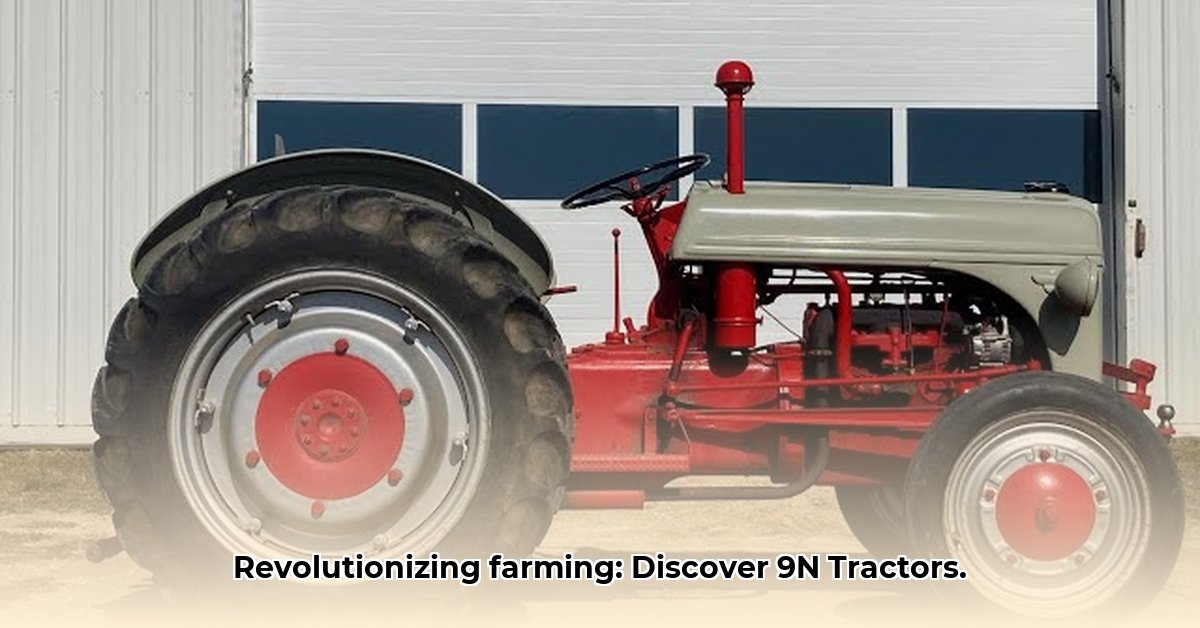
The Ford 9N: A Revolution in the Fields
The rumble of a Ford 9N tractor isn't just the sound of an engine; it's the echo of a revolution. This iconic machine didn't just ease farm labor; it fundamentally reshaped agricultural practices, empowering farmers and boosting productivity in a way few machines ever have. This article delves into the 9N's history, innovative design, and lasting impact on farming, offering a blend of technical details and captivating storytelling. For more in-depth information, check out this dedicated website: 9N Tractor Info.
The Unexpected Partnership: Henry Ford and Harry Ferguson
The 9N's creation was a surprising collaboration. Henry Ford, the titan of industrial manufacturing, and Harry Ferguson, a brilliant agricultural engineer with a reputation for both innovation and contentiousness, joined forces to build a tractor unlike any other. This unlikely pairing, though initially marked by friction, resulted in an enduring legacy for both men, and a revolutionary machine that changed the face of agriculture. Their collaboration wasn't just about engineering; it was about envisioning a future where farming was more efficient and accessible. Wasn't this an unexpected pairing that led to extraordinary results?
The Three-Point Hitch: A Stroke of Genius
The 9N's true genius wasn't simply its horsepower (a respectable 20-22 hp for its time), but its revolutionary three-point hitch system--an invention of Harry Ferguson. Before this innovation, attaching implements was a laborious, time-consuming process. Imagine the frustration of wrestling heavy tools onto older tractors. Ferguson’s design, however, simplified this, allowing quick and easy changes between plowing, planting, and harvesting. This seemingly simple innovation, still used in modern tractors, fundamentally altered farming efficiency and remains a testament to clever engineering. How did this seemingly small detail revolutionize an entire industry?
Under the Hood: Specifications of the 9N Tractor
The 9N, while not visually stunning, was built for functionality. Its 2-cylinder gasoline engine, initially employing magneto ignition to overcome wartime material shortages, provided sufficient power for the era. The lightweight design enhanced maneuverability, crucially important for navigating smaller fields and obstacles. The three-speed transmission, while basic, provided the essential functionality required for various farm tasks. This practicality ensured its widespread adoption, particularly among smaller farms.
| Feature | Specification | Notes |
|---|---|---|
| Engine | 2-cylinder, 9N gasoline | Provided sufficient power for a wide range of farm tasks, given the technology of the era. |
| Horsepower | Approximately 20-22 hp (depending on model) | A significant improvement over existing equipment for many farmers. |
| Transmission | Three-speed | Simple, yet provided the necessary functionality for common farming operations. |
| Ignition System | Magneto (early models), battery (later models) | Demonstrated innovative solutions to overcome material constraints during wartime production. |
From 9N to 8N: Evolution of an Icon
The 9N's success wasn't the end of Ford's agricultural innovation. The 2N and then the 8N followed, with the 8N seeing a significant increase in production and sales; further highlighting Ford's capacity to improve upon its initial design. These incremental upgrades, driven by farmer feedback, reveal an adaptive approach to design, ensuring the tractor continually met evolving needs. How did feedback from users shape these design improvements?
The Lasting Legacy: A Democratization of Farming
The 9N's impact transcends its production lifespan. While significantly boosting efficiency, its affordability democratized modern farming technology. Smaller farms and farmers with limited resources could now access advanced equipment, leading to improved yields, reduced labor costs, and better livelihoods. Professor David Williams, Agricultural Historian at the University of California, Berkeley, notes, "The 9N wasn't just a tractor; it was a symbol of accessibility, bringing technological progress to farmers previously excluded." The 9N’s impact extends to generations of farmers who adopted its innovations, solidifying its place in agricultural history.
Restoring a Ford 8N Tractor Engine: A Step-by-Step Guide
Restoring a Ford 8N engine is a rewarding but demanding project. A structured, phased approach is key. Meticulous documentation, including photos and notes, is essential throughout the process.
Assessment: Begin with a thorough inspection, noting damage, missing parts and the overall condition.
Disassembly: Carefully disassemble the engine, using penetrating oil to loosen stubborn parts. Document each step.
Cleaning and Inspection: Thoroughly clean each component, enabling precise assessment of wear and tear. Replace necessary parts.
Reassembly: Reassemble the engine methodically, using your documentation as a guide, ensuring proper torque specifications.
Testing and Fine-Tuning: Test the restored engine, checking functionality and making necessary adjustments for optimal performance.
Sourcing parts involves meticulous efforts. Online forums, specialty suppliers, and even junkyards can provide the necessary components, but expect to dedicate time and resources. Always prioritize high-quality parts to maintain the engine's integrity. The quality of your restoration hinges on detailed attention to each step.